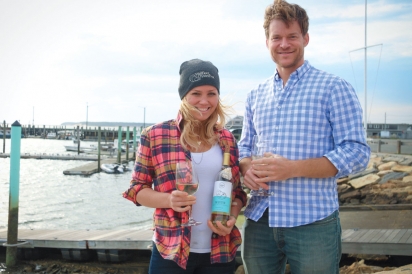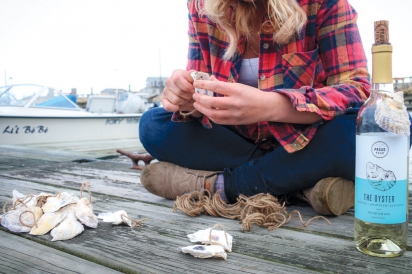Drink Wine, Save Oysters
Proud Pour is Helping to Restore the Wild Oyster Population
It’s apparent before you even open the bottle that there is something different about The Oyster wine. There’s the name, of course. And the oyster shell hanging from a piece of twine tied around its neck. The white-and-aqua label features a line drawing of an oyster above the promise, “1 Bottle = 100 Oysters Restored.” Huh?
The Oyster is a bright, crisp, highly drinkable North Coast California Sauvignon Blanc sold by a Boston-based company, Proud Pour, focused on raising money to restore the wild oyster population. In its first season the business made a measurable contribution to an ongoing restoration project in Wellfleet Harbor, currently the largest such site in the state. Once healthy and abundant, 90 to 95 percent of the oyster reef in Massachusetts has been destroyed by pollution and overharvesting; worldwide that figure is estimated to be closer to 85 percent.
In addition to being delicious—plump, sweet, briny Wellfleets, in particular, have been prized for centuries—oysters are beneficial to the marine ecosystem because they are natural water filters and they create an environment that encourages biodiversity. Proud Pour founder and co-CEO Berlin Crystal Kelly and co-CEO Brian Thurber think they have hit on a way to enlist large numbers of culinary- and environmentally-minded individuals to support their cause. Who around here doesn’t love oysters? And how better to enjoy them than with a glass of chilled Sauvignon Blanc?
Since last summer The Oyster wine has been available in 17 shops and three restaurants from Bourne to Provincetown, and others in the greater Boston area. “We put over 35,000 oysters back in the water,” says Jeff Gledhill, manager/buyer at Chatham Wine + Provisions, where The Oyster was the number-one selling wine last summer. He and his staff feature it in the shop’s eight-wine tasting station, highlighting its vibrancy and “stone fruit affect.” When people say they like its taste, “We tell them, ‘There’s a really interesting back story to this wine,’” Gledhill says. The double whammy of a great wine for a great cause has kept it selling steadily.
Kelly, 30 and a southern California native, founded Proud Pour a little over three years ago in New York. Concerned about the environment and passionate about sustainable food and wine, she learned of the worldwide decline of the wild oyster reef and efforts to restore the bivalves to New York Harbor while she was living in that city. With a background in real estate development and finance, she set out to build a business that would support the oyster restoration effort. She contacted New York’s Billion Oyster Project and the Massachusetts Oyster Project (MOP) to help shape the vision for her company, ultimately forging partnerships with both. After considering different options she decided to sell wine, she explains, because, “I wanted to choose a product that would pair well with oysters [and] that would appeal to a lot of people.”
In the winter of 2015 Kelly moved to Boston, bringing Proud Pour with her. Ten days after she arrived she met Thurber, an attorney. He had come to Massachusetts ten years earlier to lead climate advocacy for an environmental nonprofit. Andrew Jay, of the Massachusetts Oyster Project, met Kelly when she was still in New York. “We loved their concept,” he notes, “and I said, ‘How can we help?’” Kelly credits Jay with helping her make some key product decisions. After she relocated, he introduced her to the MOP network. “Just by their very presence they educate the public,” he says of Proud Pour. More concretely, since setting up shop in Massachusetts, the business has raised $5,600, “which we’ve added to and passed on to Wellfleet,” Jay says.
Specifically, the money from sales of The Oyster goes toward the purchase of recycled oyster shells that are used as cultch for oyster restoration projects. Cultch is the term for the materials that are set down in oyster beds to form a substrate, or base, on which newly released eggs can attach and develop. Cultch is usually made of oyster shells, but it can be other shells, limestone or even pieces of seawall. Collectively, they form an oyster reef. According to Curt Felix, chair of Wellfleet Comprehensive Management Wastewater Planning Committee and a leader of the town’s five-year-old oyster restoration project, “For years, we’ve been taking substrate out of the water and not replenishing it. Proud Pour’s contribution goes directly to this effort.”
Felix says Wellfleet Harbor is the only one in Massachusetts that still has a wild commercial oyster harvest, despite the depletion of the reef. Of the oysters that grow in the waters around this Outer Cape town, 30 percent are wild. The rest are farmed, though unlike some aquaculture fish and seafood, Wellfleet oysters and clams feed on phytoplankton in the local water.
Standing on the town pier in Wellfleet Harbor, it’s easy to be caught up in the beauty of the spot—the shifting hues of the water and sky, the contrasting greens of the sea plants waving close to shore—and miss the details. But look down at many points where the water meets the land, or further out at low tide, and you will see oysters, nestled close and piled on top of each other.
These were set in, or cultched, by the Wellfleet oyster restoration project. Though Felix believes cultching probably dates back to the Native Americans who first lived in the area, it had not been done for years. He says the practice was resurrected about 25 years ago by the shellfish constable at the time. “If you deplete the substrate, there’s nothing for oysters to set on and they die. You lose all that spawn. We still have a large enough natural oyster population in Wellfleet for that practice to be very effective,” he says.
The Massachusetts Oyster Project works with restaurants in the Boston area, as well as farmers and food festivals, to recycle oyster shells. (Some Cape Cod restaurants, like Arnold’s Lobster & Clam Bar in Eastham, and the annual Wellfleet OysterFest, also recycle their shells.) Shells are important for the substrate, Felix explains, because, “When oysters spawn, they look for calcium carbonate,” one of the main components of shell, on which to attach and continue to grow. After the eggs are released, there are about six to ten weeks, during which the currents and tides move them around, when “they’re literally deciding where they’re going to live for the rest of their life, where they’re going to set,” according to Felix.
Recycled shells have to be aged for a year—dried out in open air— before they can be used as cultch. MOP ages them in a facility at Save That Stuff, a recycling and resource management company in Charlestown.
In the spring, a couple of weeks before the oysters start to spawn, trucks full of oyster shells are delivered to a transfer station in Wellfleet. There, they are loaded onto dump trucks that bring them to Wellfleet Harbor. The trucks dump the shells onto the project’s cultch barge, a small boat that has been outfitted with a road sander. The sander draws the shells out of a hopper and sends them through an opening in the bottom of the boat. Several times a day from late May through late June, working around high tide, the barge navigates through the project area, depositing ribbons of oyster shell into the water.
The oyster restoration project has set close to 3000 tons of shell in the last five years. (Felix estimates the money Proud Pour has contributed has bought about 100 tons.) This has led to the restoration of approximately 35 acres of reef and two hundred million oysters. Of the bivalves being restored in Wellfleet, 90 percent are for diners to eat and enjoy. The remaining 10 percent are for the environment.
“There are major ecosystem benefits that come from having oysters that you don’t harvest,” Felix notes. Water quality and disease resistance are chief among them. Adult oysters can filter up to 50 gallons of water per day. Already, there has been a 70 percent reduction in nitrogen at the Wellfleet project site and an overall improvement in water quality.
In a small but graphic example, Felix points to what he calls “black mayo,” the muck along the shore at low tide. He explains that when phytoplankton dies it creates the mud. A plentiful oyster population feeds on phytoplankton, helping to keep the mud levels low.
Building the reef creates a habitat for thousands of other species of fish, shellfish and other organisms to live. It also provides refuge for young fish when they are growing up. Felix says studies show that some fish spend up to their first two years in an oyster reef or salt marsh. “If you don’t have at least one of those, you don’t have protection for fry [baby fish]. You can put catch limits on fish ‘til the cows come home, but… if we don’t fix the breeding habitat problem, we’re not ever going to restore our fish stocks,” he notes.
Though oysters can live to be 80 years old, there are no senior citizen bivalves living in Wellfleet Harbor, which is something the restoration project is hoping to change. Any oyster older than ten is likely to have survived a major disease outbreak, which enhances disease resistance. When a disease hits, beds have to be shut down, which can have harmful to devastating effects on those whose business depends on the harvesting and sale of oysters. Growing the population will help, too. “I think with a larger population we’ll also start to see lower disease incidence,” says Felix, because each animal has less exposure and stress.
“With all the focus on water quality,” Felix adds, “Wellfleet oysters will continue to be among the most premium in the marketplace.” And Proud Pour offers a delicious accompaniment that also contributes to the long-term survival of their habitat.






